


“Don’t Wait for Opportunity, Create it. “George Bernard Shaw
Strive

not to be a success, but rather to be of value.Albert Einstein




“Don’t Wait for Opportunity, Create it. “George Bernard Shaw
Strive

not to be a success, but rather to be of value.Albert Einstein
Vikram Barate writes about how adopting 5G can enable the healthcare industry to become more value-driven and patient-centric. – “The existing healthcare system will need to adopt 5G to resolve some of its current challenges that include escalating costs of healthcare, inefficiencies in healthcare administration...”
Vivian John throws light on the applications of Natural Language Processing in Healthcare Analytics and its potential to improve care. –“Much of the current state of healthcare analytics is based on structured data. This includes data that can be easily tabulated and analyzed, such as claims data, laboratory test results, and demographic information.”
V K Venkatesh writes about the second phase of Healthcare 4.0 which introduced the world of Virtual and Augmented Reality to us. – “Metaverse shows great potential in the healthcare segment and enhances the association between the patient and the physician. It will help resolve several issues like versatility or geological impediments, psychological well-being, etc.”
Sundaramoorthy S writes about how the combination of Zero Trust and Identity & Access Management can ensure improved security in the networks. – “Zero Trust is a network security model that is based on a strict identity verification process.”
Priyanka Pandey explores how inclusive design has an impact on user experience. – “It is just an approach and a series of practices that intentionally include and enable users who have a permanent, situational, or temporary disability or experience discrimination due to being part of a minority or oppressed group.”
Hari G shares his insights on how adopting Low-Code No-Code platforms can bring multiple business benefits. – “Low-code/no-code is more cost-effective than traditional development approach, as it includes small teams, few resources, and low maintenance & infrastructure costs.”
Impacts of climate change have been felt globally through strange and extreme weather phenomena. The recently held COP27, UN’s conference on climate change, further highlighted the need for action to mitigate this issue.
A study stated that, “the global ICT sector—consisting of all data centres, data transmission networks and connected devices—accounted for around 700 Mt of CO2-equivalent in 2020, corresponding to around 1.4% of global GHG emissions.” The study suggested that only a fraction of emissions from the ICT sector is attributable to AI and ML. However, due to lack of definition, data and an established methodology, the exact share remains a mystery.
AI has various applications in our lives and the models are getting increasingly better over time. The accuracy of the models depends on vast computational resources that necessitate similarly substantial energy consumption. For e.g., Large Language Models (LLMs) require vast amounts of energy to train and run. However, are training and running the only two phases that we should consider while calculating carbon footprint? There are other phases and processes that use energy, like manufacturing the supercomputer’s hardware and maintaining its computing infrastructure. Computing power also varies between different algorithms and different stages in its development and use.
Furthermore, there are other wide-ranging effects of AI that contribute to their carbon footprint. For instance, recommendation and advertising algorithms that drive people to buy more things, which causes more carbon dioxide emissions. Thus, it is also important to understand how AI models are used. Experts agree that more work needs to be done to understand the environmental impact of AI and ML. Insights from such research will help people shift to more efficient ways of using AI, such as fine-tuning existing models instead of pushing for models that are even bigger.
We have some insightful articles in this edition.
Vikram Barate has written, ‘5G for Healthcare’.
Vivian John has written, ‘Challenges, Benefits, and Future of NLP in Healthcare’.
V K Venkatesh has written, ‘Healthcare 4.0: How can Metaverse Enhance the way Healthcare Works?’
Sundaramoorthy S has written, ‘Zero Trust Security for Identity and Access Management’

Hari G has written, ‘Low-Code No-Code Platforms – Cost Effective Automation’
Priyanka Pandey has written, ‘How to Create an Accessible and Inclusive Design?’ Happy Reading!
Team enGAge wishes everyone happy holiday and a very Happy New Year!


Inspired by living systems, researchers have developed a new material that changes its electrical behavior based on previous experience, effectively giving it a basic form of adaptive memory. Such adaptive materials could play a vital role in the next generation of medical and environmental sensors, as well as in soft robots or active surfaces.

Researchers at the Eelkema Lab have discovered a new process that uses fuel to control non-living materials, similar to what living cells do. The reaction cycle can easily be applied to a wide range of materials and its rate can be controlled. The discovery is a step towards soft robotics; soft machines that can sense what is happening in their environment and respond accordingly.

MIT-developed liquid neural networks, AI/ML algorithm capable of learning and adapting to new information while on the job, had an issue with data throughput. But by solving a differential equation, that had stumped mathematicians since 1907, behind the interaction of two neurons through synapses, the team will now be able to unlock a new type of fast and efficient artificial intelligence algorithms.
Researchers at North Carolina State University have developed an energy-efficient soft robot inspired by the biomechanics of the manta ray. It can swim more than four times faster than previous swimming soft robots. The robots are called ‘butterfly bots,’ because their swimming motion resembles the way a person’s arms move when they are swimming the butterfly stroke.



The healthcare industry is increasingly adopting newer, technology-led ways of providing its services, thanks to the surge in digital innovations. As hospitals and other healthcare centers become more valuedriven and patient-centric, it is evident that digital transformation has been instrumental in facilitating research, in the rapid development of medicines and vaccines, and in making healthcare mobility a reality.
The pandemic accelerated transformative initiatives such as remote care since healthcare players hurriedly increased their investments and focus on meeting pandemic-induced challenges. With the pandemic almost behind us, one of the factors sustaining the momentum is the emergence of 5G technology - with features that overcome the limitations of the previous generations of wireless networks.
5G offers almost unlimited bandwidth, very high speeds of up to 20 Gbps with low latency, enables network slicing, and allows an exponential number of devices to be connected to the network. These capabilities throw open a wide range of use cases for healthcare including assisted health services, improved quality of life, and better patient experiences. A recent Ericsson Report states that healthcare would be one of the largest beneficiaries of the growth of 5G, and per Grand View Research, the global 5G healthcare market is expected to grow at 34.5% CAGR between 2022 and 2030.

The existing healthcare system will need to adopt 5G to resolve some of its current challenges that include escalating costs of healthcare, inefficiencies in healthcare administration, lack of unified electronic records, unharnessed healthcare data volumes, poor patient engagement/experiences, the need to support new service models like remote monitoring and care, the need for robust security and privacy for sensitive
healthcare data, especially with healthcare being a prime cybercrime target, and more.
On the other hand, healthcare is also undergoing a tremendous digital transformation thanks to the increasing use of technologies like the Cloud, Big Data, IoT/IoMT, and AI/ML. While these will help pull healthcare out of the traditional ways of working and launch it on a progressive path, 5G will play a crucial role as the backbone to support these technologies. Limitations in current communication networks cause data transmission delays, network congestion, low reliability, and the inability to handle high data volumes – all of which are not conducive to healthcare transformation.
5G is being acknowledged as the technology enabler for the big shift to value-based and preemptive care, and to drive all-around process efficiencies. For instance, it would help fast and secure transmission of streams of data for continuous remote monitoring of patients. With the capability to handle huge volumes of data at high speeds and negligible latencies, 5G would empower healthcare systems with insights for data-driven decision-making through big data analytics. Enhanced services like remotely done surgeries, connected ambulances, and other connected care use cases - that are quickly becoming commonplace – require the high bandwidth of 5G for rapid transmission of high-resolution images and videos, patient records, data from devices, etc. in realtime. Network slicing features and capabilities will enable high reliability, security, and privacy for remote services and smart hospitals and care centers. 5G would enable a digitally connected healthcare system since there is no limit to the number of devices that can be connected to a 5G network.

Let’s look at a few 5G enabled application areas -
Remote patient care and other e-health services are now becoming mainstream offerings in the healthcare industry. Analysts expect that 5G enabled telemedicine will grow at a CAGR of 16.5% until 2023. It is a time and effort-saving alternative for routine follow-ups, long-term management of chronic diseases, continuous monitoring and interventions, remote procedures/surgeries, and more.
Surgical teams performing complex surgeries can take the guidance of experts by live-streaming highdefinition videos over a 5G connection in real time. 5G-based MRIs or CT scans that offer higher mobility and bandwidth can be transmitted for real-time diagnostics and finalizing the course of treatment/ procedure. This will allow healthcare professionals to offer better care and improve the quality of service provided as experts can support from anywhere in the world, without being confined by physical boundaries.
Connected ambulances can make a big difference in saving patients in need of emergency care as it allows paramedics to live-stream patients while still on their way to the hospital, transfer data in real time, and help hospitals be fully prepared for incoming patients before they arrive. For instance, in 2019, Vodafone set up 5G-connected ambulances in Milan to help paramedics and emergency departments prevent treatment delays.
With the increasing use of embedded devices, wearable technology, and mobile apps, remote patient monitoring is gaining significant momentum. As 5G offers low latency and high speeds and reliability to transfer data, Class II and III wearable medical devices monitor oxygen, pulse, take ECG, etc. and transmit this data to their healthcare facilities. These devices help healthcare professionals and hospitals monitor patient vitals remotely, analyze their current health conditions, prevent hospitalizations through proactive care, and discharge patients faster due to improved efficiencies. Over time, these devices will play a more significant role in offering better healthcare services to patients.
The NB-IoT (Narrowband IoT) standard focuses on
energy efficiency for low-cost, low-maintenance IoT devices to transmit small amounts of data periodically. But this energy efficiency comes at the cost of real-time transmissions and bandwidth limitations. NB-IoT powered by 5G will see a huge jump in performance and bandwidth at very low latencies for such IoT devices.
Healthcare facilities like psychiatric centers or geriatric care homes can benefit immensely from 5G-based smart cameras, which would help caregivers and healthcare professionals monitor patients in real time, recognize anomalies in their behavior, and intervene immediately before any escalations. This would also help them tweak the course of treatment for better health outcomes.
Using 5G with Augmented Reality (AR) and Virtual Reality (VR) opens several new possibilities in assisting those who need help with performing day-to-day activities. Leveraging this, healthcare professionals can give people with physical impairments a chance to lead normal lives. Immersive VR and AR applications can create interactive experiences allowing doctors to conduct real-time diagnoses and take immediate treatment decisions remotely.
AR/VR is used by healthcare professionals to distract patients and minimize pain, improve patient health, and reduce time spent at the hospital. Popularly referred to as distraction therapy, healthcare workers put the patient in a simulated environment to reduce the anxiety that can arise from going through an experience as simple as a needle prick or more painful situations like surgery.
Healthcare data digitalization, integration, and interoperability are foundational for digital healthcare transformation. 5G can play a key role in the management of large data volumes, secure transmissions, and big data analytics. 5G can also help with the predictive management and resilience of hospital assets that include medical equipment, infrastructure, and applications.
As we have seen, the possibilities with 5G in healthcare are vast and healthcare players need to judiciously join the 5G bandwagon. As with any new technology, there are plenty of challenges as well like
compatibility of current devices with 5G, the need for suitable networks to support 5G, the need to upgrade infra, and applications to meet 5G requirements, and more. Looking beyond these challenges that need to be resolved, leveraging 5G capabilities in tandem with other emerging technologies, can result in a highly connected, efficient, and an intelligent healthcare system that offers enriching patient experiences while reducing healthcare costs.
Vikram Barate serves as Engineering Director at GS Lab | GAVS for Communications technologies expanses like Telecom (4G/5G), VoIP, UC/CC, Multimedia solutions (audio/video/images), and Collaboration platforms. He also leads the GS Lab| GAVS communication technologies group and represents GS Lab | GAVS in forums like ONF, GSMA, and TIP. In his last 22 years of IT experience, he has built and led expert teams and niche products from the inception phase. Apart from communications technologies, Vikram brings expertise in Security, Embedded, and Networking domains.

The current state of healthcare analytics is in a bit of a flux. The industry is still coming to grips with the potential of big data, and there are a lot of different approaches being taken to try and make sense of it all. NLP is one tool that is beginning to be used more frequently in healthcare analytics, as it can help to identify patterns and trends in large datasets.
Much of the current state of healthcare analytics is based on structured data. This includes data that can be easily tabulated and analyzed, such as claims data, laboratory test results, and demographic information. However, there is a growing need for analytics that can make use of unstructured data as well. NLP (Natural Language Processing) is one way to glean insights from unstructured data. For example, NLP can be used to analyze free-text clinical notes. This could provide valuable insights into disease progression, treatment effectiveness, and more. There are many potential applications for NLP in healthcare analytics. However, the technology is still in its early stages of development. There are challenges associated with making NLP scalable and accurate enough for real-world applications. Nonetheless, NLP holds great promise for healthcare analytics and is worth further exploration.
Uncover patient insights buried in medical text with solutions. One of the biggest challenges facing healthcare analytics today is the lack of standardization. There are a plethora of different data sources, formats, and terminologies in use. This makes it difficult to compare different datasets.
Another potential application for NLP is in disease surveillance. By analyzing large amounts of data, NLP can help to identify patterns and trends in disease outbreaks. This information can then be used to help prevent or contain outbreaks.
Challenge is the sheer volume of data that is being generated. It is estimated that by 2025, the global healthcare data volume will reach 2,314 exabytes! That’s a lot of data to sift through! But despite these challenges, healthcare analytics continues to forge ahead. New techniques, such as NLP, are being used to make sense of unstructured data sources, such as doctor’s notes. NLP can help us to automatically extract important information from these notes, such as diagnoses and treatment plans. So, while there are still some challenges to be overcome, healthcare analytics is making great strides. With the help of NLP, we are unlocking the power of big data and using it to improve patient care. There are various phases of language processing or as we like to call them as various levels of NLP as depicted in Fig,1.

There are several different applications for NLP in healthcare analytics. One of the most promising is its ability to help identify adverse events. Adverse events are a major problem in healthcare, and they can often be hard to spot. By using NLP to analyze patient records, it may be possible to identify adverse events sooner and help prevent them from happening.
Another use is to detect errors in medical records. For example, NLP can flag cases where a procedure was incorrectly recorded, or a medication was prescribed incorrectly. This can help reduce the risk of medical errors and mistakes.
The major benefit to enhance existing NLP systems can be the combination of multiple NLP techniques. For example, text generation can work as a data augmentation method for achieving comparable results in many applications with limited original data, such as training systems and other clinically relevant tasks. Through automatic question generation, questionnaires and surveys for population screening data can be generated from EHRs, which may outperform handcrafted ones. Machine translation has also proven beneficial for various text-based
tasks by increasing the availability of multilingual healthcare information, implying the possibility of improving the performance of current systems. In addition, exploration of general knowledge and domain knowledge in the field of NLP for smart healthcare deserves further attention and verification.
There are also some challenges that come with using NLP in healthcare analytics. One challenge is that there are many different dialects of English used in medical records. This makes it difficult for NLP algorithms to understand the content of these records. Another challenge is that medical records can be full of jargon and abbreviations that are unfamiliar to most people. This can make it difficult for NLP algorithms to accurately interpret the information contained in these records.
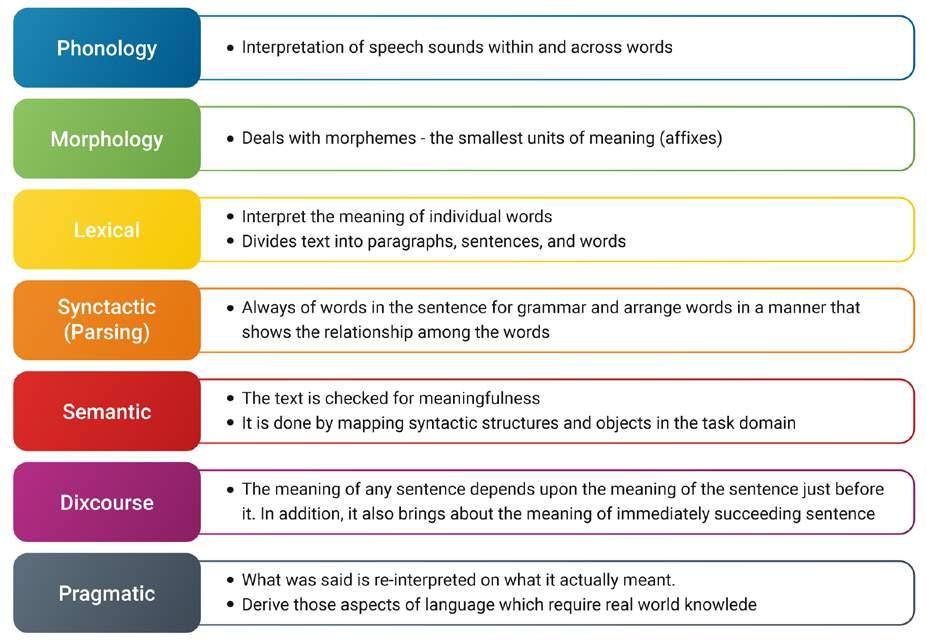
There are several uses for NLP in healthcare analytics. One common use is to identify keywords
in medical records. NLP is still a relatively new tool, and there are still a lot of unexplored potential applications for it in healthcare analytics. As more and more organizations begin to realize the power of NLP, we will likely see even more innovative uses for it in the future. Finally, NLP can be well evolved, when we identify several directions for future works, notably

combining multiple NLP techniques, developing end-to-end applications, few-shot learning, and incorporating multimodal and longitudinal data. With more diverse data flowing in and understanding new conceptual trends in market, we’ll be processing and formulating new trends in Clinical. NLP. Fig.2 shows new trends in entity recognition in NLP.
Fig 2: Clinical NLP of Electronic Medical Record (Source-NVIDIA) References: 1. Chatbotsmagazine.com (https://bit.ly/3O9bLSq) 2. Zhou et al.: Natural language processing for smart healthcare
Vivian is part of the Healthcare CoE (Centre Of Excellence) team at GS Lab | GAVS. He has a master’s degree in Avionics Systems and has an experience of around 3.5 years in AI, Cloud-Ops, and automated systems. He is interested in exploring new technologies. He is also an avid angler.

The traditional healthcare market has always been about physical appointments, manual patient examinations, and treatment protocols completely dependent on human intervention. However, with COVID-19 the need for contactless treatment propelled and evolved the healthcare industry to an unimaginable extent. With this we have a new eraHealthcare 4.0, a tech-driven concept that enhances the overall healthcare experience.
Like the concept of Industry 4.0 that revolves around smart machines getting access to large amounts of data, allowing them to make decisions without human involvement, Healthcare 4.0 also refers to a wide range of tech possibilities that laid the new foundation for the healthcare sector.

Over the first phase of Healthcare 4.0, we have seen the utmost usage of the Internet of Medical Things,
Medical Cyber Systems, Health Cloud, Artificial Intelligence, Big Data Analytics, Machine Learning, Blockchain, etc. This has drastically improved the quality, flexibility, productivity, cost-effectiveness, and dependability of healthcare services.
The second phase of Healthcare 4.0 introduced us to the world of Virtual and Augmented Reality.
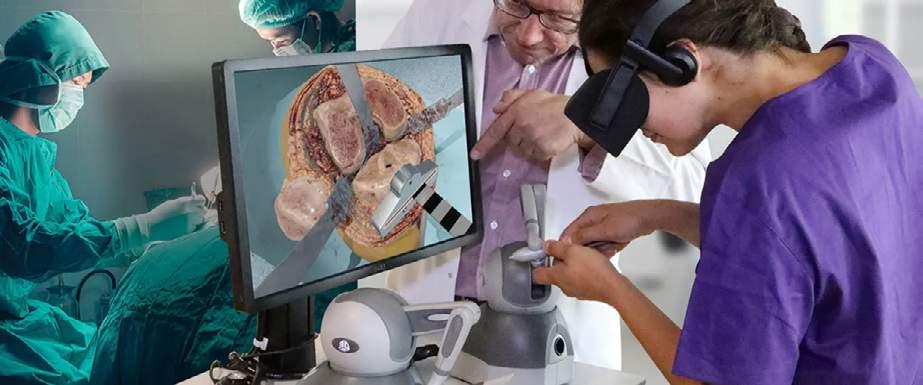
Virtual reality is a simulated 3D environment that enables users to interact with virtual surroundings in a way that approximates reality as perceived through our senses. This approximation of reality is accessed through a VR headset that takes over a user’s field of vision. Imagine yourself performing surgery while you are in the classroom with your professor who is explaining the procedure to you. Virtual Reality gives you a simulated experience.
On the other hand, Augmented reality is less immersive than VR. It adds a digital layer on top of the real world enabling users to still interact with their real-world environment. The Pokémon Go game is
an early example of AR. Google Glass and heads-up displays are some of the AR products. Physicians can now explain a procedure more clearly to a patient with the help of AR.
But now, humans all around the globe, are witnessing an inevitable invention of the internet, the third phase of Healthcare 4.0, i.e. the Metaverse.
The word Metaverse is a combination of two words – in Greek meta means ‘beyond’ and verse means ‘universe’, beyond the universe. The Metaverse is a space where an individual will be able to perform work, learn, play, or create; including experiences that are not possible in today’s world.
By 2024, it is expected that the Metaverse market size will be approximately US$800 billion. And as we discuss, many Healthcare industry specialists will be working towards exploring the various game-changing possibilities it can bring to the table.
Metaverse technology is still evolving, however, it includes the combination of three major technologies — Artificial Intelligence (AI), Augmented Reality (AR), and Virtual Reality (VR). Together, they open up a new window and endless possibilities for providing treatments, bringing down operational costs, and a better understanding of results in medical services.
Metaverse shows great potential in the healthcare segment and enhances the association between the patient and the physician. It will help resolve several issues like versatility or geological impediments, psychological well-being, etc.
• Telemedicine
The COVID-19 pandemic helped in advancing the utilization of telemedicine in such a way that now the utilization rate has increased to 95%. Metaverse will upgrade telemedicine visits with
a virtual office, where patients and specialists can meet in a 3D center and provide pre and post-operative patient counseling. It will also provide virtual reality-mediated exercises to improve their emotional regulation abilities. This personalized approach to patients can increase patient satisfaction as well as outcomes.
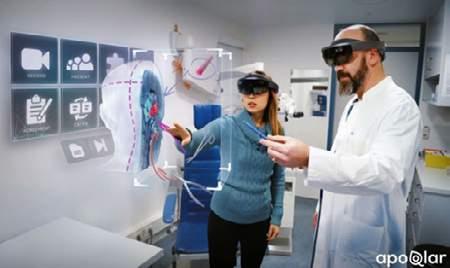
• Advanced Metaverse Powered Surgeries
Metaverse can be developed and utilized for supporting diagnosis and for pre-surgical preparation and training, in addition to their potential for usage in operating rooms. Specialists can utilize the platform to study the patient’s anatomy and pathology in 3D, plan surgical procedures in the virtual environment, and practice the surgical procedures or medical device usage before operating on a patient.
• Advanced Metaverse Powered Medical Training
Gone are the days, when medical students get just knowledge transfer or limit themselves from practical experiences. This is the most significant advantage the healthcare segment could gain with Metaverse. With Metaverse, medical training will be more effective in areas that need advanced practice and interactions. It will provide the learner with an immersive environment that gives more insight into human anatomy and pathology and provide a 360-degree perspective of a patient’s disease or mimic treatments.
There is no doubt that Metaverse is going to be beneficial for the healthcare industry, but this innovation accompanies certain limitations too. No matter what Metaverse promises, the current lack of privacy regulations for the Metaverse presents many limitations such as:
• Patient protection and privacy regulations
• Cyber attacks
• Extensive data collection
• Data rights and ownership
• Higher operational costs
• User-to-user privacy
Overcoming these limitations is challenging but on the other side, it possesses a bright future for the healthcare segment. Metaverse is not just part of science fiction anymore, it has become a part of Healthcare 4.0. It is time that we embrace Metaverse
and its applications and we continue exploring ways to make it safer, inclusive, and accessible for everyone.
• https://www.techtarget.com/whatis/feature/ What-is-the-metaverse-An-explanation-and-indepth-guide
• https://www.ncbi.nlm.nih.gov/pmc/articles/ PMC8423174/
• https://www.jumpstartmag.com/how-is-themetaverse-changing-the-medical-field/
• https://healthcare-digital.com/digital-healthcare/ what-health-40
• https://www.netscribes.com/metaverse-inhealthcare/
• https://www.healthysimulation.com/14843/ apoqlar-promises-the-future-of-surgery-withhololens/
• https://3dprint.com/272112/fundamental-vr-ischallenging-traditional-medical-training-in-theage-of-covid/
Venkatesh is part of Solutions & Strategy team at GS Lab | GAVS. He has 6+ years of work experience focused on presales, market research and analysis and sales enablement. He is responsible for enabling and supporting Healthcare deals as part of Solutions and Strategy group.

As the IT industry is moving the infrastructure towards multiple models like Hybrid, Cloud and Multi-Cloud models, ensuring security is the biggest
challenge. Let us dive into how the combination of Zero Trust and Identity & Access Management can ensure improved security in the networks.
Zero Trust is a model which was first introduced by Forrester Research. Even though it was not entirely a new concept, it has gained its own place in the rapidly growing IT industry for its security-oriented results on network security and architecture.

Zero Trust is a network security model that is based on a strict identity verification process. According to the framework, only authenticated and authorized users and devices can access applications and data.
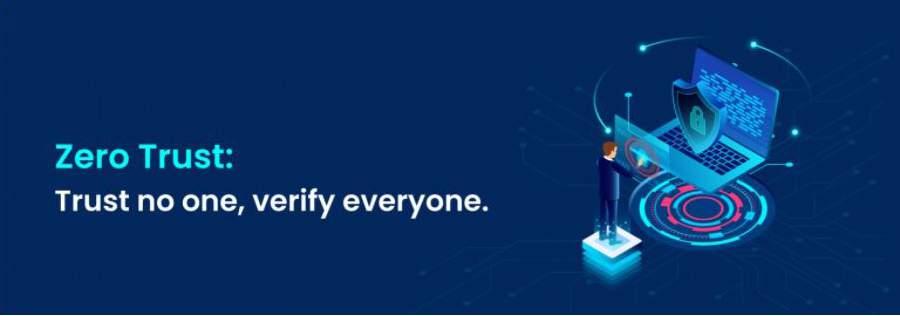
As growing business networks become targets to the hackers, global business players are in need of an upto-date security model that effectively adopts to the complexity of the modern environment, embraces the hybrid workplace, and protects people, devices, apps, data, and networks wherever it is positioned.
Below are few reasons why we should adopt Zero Trust
•
Empower the network users to work with enhanced security anywhere, anytime, on any device.
• Cloud Transition
Enables digital transformation with security intelligence on complex environments like hybrid, and multi-cloud.
• Minimal
Blocks the security gaps and reduces the risk of lateral movement.
Authentication and authorization must be done based on all available data points, including user identity, location, device health, service or workload, data classification, and anomalies.
User access must be limited with just-in-time and just-enough-access (JIT/JEA), risk-based adaptive polices, and data protection to help secure both data and productivity.
Minimize blast radius and segment access. Verify end-to-end encryption and use analytics to get visibility, drive threat detection, and improve defenses.
Below are few key defense areas of Zero Trust Security Model in the complex networks:
• Identities
• Data
• Infrastructure
• Network
• Applications
• Endpoints
Identity and Access Management is the first step of Zero Trust security model. Identity is a core element of Zero Trust to verify explicitly. As soon as Zero Trust is implemented, it will unify the Identity and Access Management environment in cloud and on-prem applications and resources.
If all the applications, data, infrastructure, machines, and users are in the open internet, with Zero Trust we differ from a traditional model of implicit trust to explicit verification.
• Instead of assuming the Identity of the user that is in high session because of the network which the user is in, verify the identity explicitly
• Verify the device explicitly, instead of assuming the user has a valid machine because of the network
• Explicitly classify and encrypt data, instead of allowing access to file shares because the user is on the network
As we progress, more processes and data are being moved to the internet. When a user accesses their cloud hosted email from a device outside of the secured network, all the elements of the activity fall outside of the secured networks. The device, network, and application (code and hardware) are not in your direct control.

With the many networks, devices, and applications required in our daily business, the only common denominator is the Identity (User), which concludes “Identity is the control plane”. It is critical to establish who the user is as the core of trust for other transactions. If the Identity of the user is not known, no other system access control or security is enough. Once we are sure of who the user is, we can explicitly verify every element of access whether our resources are on-premises, in cloud-hosted servers, or managed by third-party SaaS.
A robust Zero Trust strategy considers the full context of the session to determine its overall risk, the identity of the user, plus the state of their device, the apps which are accessed by the user, and the sensitivity of the data which the user accessed. This
analytical data which helps admins in deriving the policies for block listing, white listing or to control it by deploying additional authentication controls such as MFA, restricting functionality such as downloads, or applying compliance controls such as terms of use. By bringing such controls in place, its difficult for the hacker to access the networks. This strategy not only protects against external threats, but it also helps create guardrails so well-meaning employees can use organizational resources responsibly.
A framework of controls such as additional authentication factors, terms of use, limited access, and other session semantics regulates access. This guarantees we are “secure at access” in our Zero Trust approach.
Let’s discuss a simple example of a vulnerable scenario. Consider an access card to the building premises which is lost by an Identity user, if the access card is not blocked in time and the same access card is identified by a threat, it’s a potential gap in the security. This is the place where the Zero Trust need to be enforced, where the suspected user holding illegal/toxic access must prove the Identity externally with Zero Trust. In this case, the threat surface will be filtered, and security will be ensured.
This checklist will help quickly deploy critical recommended actions to protect your organization
• Strengthen your credentials
• Reduce your attack surface area
• Automate threat response
• Utilize cloud intelligence
• Enable end-user self-service
A successful Zero Trust strategy requires seamless and flexible access to applications, systems, and data while maintaining security for both users and the resources they need to do their jobs. It requires being cloud-ready, starting with identity, and then implementing above check list to secure all areas of your environments.
Sundar has more than 13 years of experience in IT, IT security, IDAM, PAM and MDM project and products. He is interested in developing innovative mobile applications which saves time and money. He is also a travel enthusiast.
 Hari G
Hari G
Developing software is a very complex process. It requires hiring expensive technical resources. McKinsey and Oxford’s join study suggests that half of all large IT projects—defined as those with initial price tags exceeding $15 million—massively blow their budgets. On average, large IT projects run 45 percent over budget and 7 percent over time, while delivering 56 percent less value than predicted.
Therefore, Low-Code and No-Code platforms have started gaining popularity. Simple automation can be done without much manual coding with the help of Low-code/No-Code platforms, which can lead to faster delivery of application within less time.
Low-code & No-code is a rapid application development (RAD) approach. These apps have the pre-written codes and template which can be used for developing automation and building applications with little or no knowledge of programming.
Low code – It enables automation through visual process flow like drag and drop and pull-down menu interfaces. Some handholding is required by developers in the form of manual coding or scripting. Examples of low code applications include robotic process automation, appraisal management software, external plugins’ integration, mobile and website application development, business process management platforms, cloud-based next-gen technologies, such as machine-learning libraries, and legacy app modernization.
No Code – As per name, it doesn’t need any code. It contains pre-made designs and interface can
be changed as per the requirements. It will not restrict the app development as per the pre-made design, it will provide flexibility to make changes and develop an app as per your business requirement. Furthermore, it is a cost-effective mechanism to build an application for the business in short span of time. Examples of these No-Code applications are self-service apps for businesses, apps for mobile, workflows builders, content management platforms and dashboards.

List of some of the current Low-Code No-Code platforms, along with their usage.
1. Analytics & Predictions Platforms
• Amplitude
• Obviously
• Mixpanel
2. Forms, Rules, and Workflow – For automations
• K2.com
• Quick Base.com
• InRule
• Decisions
• FlexRule
• Kissflow
• Pipefy.com
3. For Admin Tools – Admin tasks can be made easier with these platforms
• Retool.com
• Skuid.com
4. Developing Application without coding knowledge
• Claris FileMaker
• Salesforce Lightning
• Outsystems
• Appian
• Pega
•
Microsoft PowerApps
• Radzen
• Zoho.com
• Netlify
• Heroku
• Firebase
• Democratization of technology: Both low-code and no-code solutions can be used by different kinds of users, which reduces dependency on hard-to-hire, expensive coders, and developers.
• Increase Productivity: Low-code/no-code improves the velocity of development, reduce the timelines from months to days which helps in faster rollouts of products.
• Cost-effectiveness: Low-code/no-code is more cost-effective than traditional development approach, as it includes small teams, few resources, and low maintenance & infrastructure costs. ROI is also better due to quick agile releases.
• Consistency in Architectural Designs: As coding is less required or not required for development, it ensures design and code consistency. It is also beneficial during debugging applications, so instead of understanding framework developers
• Zapier
• IFTTT
• Unito
• Airtable
• Segment
Above are some available platforms in the market, which provide similar business benefits.
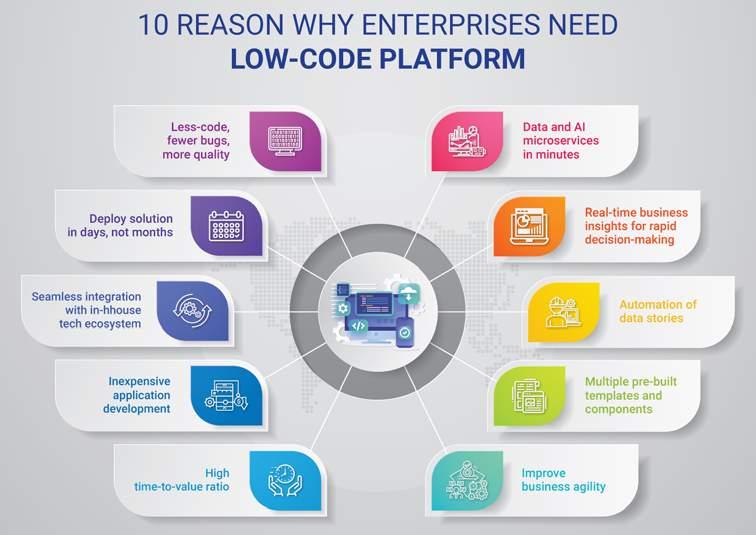
can spend their time in troubleshooting the issues.
• Build than buy: Cost effective in-house customization can shift the needle from “buy” to “build” in the buy vs build dilemma.
This article provides an overview on the importance of these platforms. Based on the requirement, we can select the platform from the above provided list and complete the automation.
The usage Low-code and no-code platforms are likely to increase in the coming future even by professional developers to avoid more mundane programming tasks.
Hari is part of the Quality Management function at GS Lab | GAVS, handling the Assurance and Delivery excellence. He is driving process improvement activities and Digital transformation project across GAVS. He is passionate about learning new technology. In his free time he likes watching movies and TV shows and spending time with his family.

– Billy Gregory, Digital Accessibility Professional
Visualize this - you are in a garden, enjoying the nature around you. What did you think of? Beautiful blue sky, green grass, and colorful flowers? Now visualize the same world in muted colors – grey sky, grey grass, and not-so colorful flowers. This is exactly how some people with color blindness see everything around them. But not being able to enjoy the different colors of nature is not the biggest challenge a color-blind person faces.
Imagine another scenario where you are at a supermarket, buying groceries. You pick up a packaged food item and want to check if it is vegetarian or non-vegetarian. What do you do? You check for the green or brown symbol on the package. You then go to the fruits section and try to pick a ripe banana. You know you have to pick the yellow one as it is ripened, and not the green one. Then, you get into your car to drive back home but the traffic signal on the way is red. So, you stop and wait for it to turn green. Sounds like an everyday situation we face, right? But what would be the situation if we could not distinguish between these colors? There was no way to find out if the packaged food was veg or nonveg or what was the color of the traffic light. This is why we need accessible and inclusive designs. And accessibility and inclusivity are more than just adding an ‘others’ option in the gender section of a form.
Accessible and Inclusive design is not a different type of design process. It is just an approach and a series of practices that intentionally include and enable users who have a permanent, situational, or temporary disability or experience discrimination due to being part of a minority or oppressed group.
It is about adding an extra dimension of inclusion to the existing design thinking process. At its core, accessible and inclusive design is about empathizing with users and adapting interfaces to address the various needs of those users.
With the ever-increasing internet reach, everyone is producing content and products that instantly have a global reach. With that power comes the responsibility to ensure that these products are accessible, inclusive, and respectful of their global audiences’ diverse requirements and social identities. Here are some statistics for people who might be skeptical about why it matters:

• Over 1 billion people – about 15% of the world’s population live with some form of disability
• 44% of consumers worldwide feel they are not fully represented by the people they see in ads
• 49% of Gen-Z consumers, in the US, stopped purchasing from a brand that did not represent their values
• Around 300 million people globally have color vision deficiency
• Approximately 1 in 12 men (8%) and 1 in 200 women (0.5%) have color blindness
Digital interfaces that do not prioritize accessible and inclusive design can negatively impact the user experience of such a large audience.
Mostly, people tend to categorize everyone into two groups when it comes to ability: Abled and disabled. But if we really think about it, everyone is just on different areas of the spectrum of ability. Some people can see everything clearly, some might need glasses, some might not be able to see some specific colors while others might not be able to see anything at all. Some can stand or walk without any difficulty, some might walk with a limp, some might need
“When UX doesn’t consider ALL users, shouldn’t it be known as ‘SOME User Experience’ or… SUX?”
walking aids like crutches, and others might need a wheelchair. And it is just a matter of time before we change our position on this spectrum. Getting an eye check-up can dilate your pupils and leave you with temporary blurry vision or an injury on your leg can put you on temporary crutch support. Even with age, our abilities start to deteriorate. Hence, it is important to understand and learn about users of all backgrounds and abilities.
Color blindness (color vision deficiency, or CVD) is a common term used for the condition where individuals are not blind but just confuse shades or lose their ability to distinguish between different colors. This condition is caused due to defects in the cells of the eyes and the type and severity of these defects determine the type of color blindness. Different types of color blindness are:
1.
This is the most common type of color blindness
which makes it difficult to tell the difference between red and green. There are 4 types of red-green color blindness: Deuteranomaly, Protanomaly, Protanopia, Deuteranopia

People who are red-green color blind are often surprised to find out that peanut butter is NOT green!
This type of color blindness makes it difficult to tell the difference between blue and green, and between yellow and red. There are 2 types of blue-yellow color blindness: Tritanomaly, Tritanopia.
This type of color blindness is quite uncommon and is also called monochromacy. It takes away your ability to see colors at all and can also make you more sensitive to light.
 Figure 1: Traffic Lights - Normal Vision
Figure 1: Traffic Lights - Normal Vision
Some practices that can lead to accessible and inclusive design solutions are:
1. Working with the right team: Building a diverse team who have a multitude of identities and abilities helps in overcoming unconscious bias and exclusion behaviors.
2. Educating stakeholders: Engaging stakeholders in research, sharing examples, and explaining to them how different people use technology is essential.
3. Involving users: Using user research and cocreation to deliver to excluded communities, as designing with them is more important than designing for them.
4. Establishing design guidelines: It is essential to have guidelines in place and follow them for every product design and development. There are some web accessibility guidelines published by the Web Accessibility Initiative of the World Wide Web Consortium which can be helpful.
Our design choices can inspire, motivate, connect, empower, and support users but can also alienate, offend, marginalize, misrepresent, and create barriers for them, which obviously is not a good user experience. Some design ideas to use are:
1. Not relying on color codes alone to convey information and use texture, pattern, shapes, numbers, etc in designs instead.
2. If color coding is required, being more intentional about what colors are paired together.


3. Providing sufficient contrast between foreground text color and background color.
4. Including text alternatives for non-text content like images and videos.
5. Using images and copy that includes people from different backgrounds and abilities.
6. Utilizing tools like color blindness simulator, to test product designs and ensure their accessibility.
Figure 3: Accessible UX design
Figure 4: Increasing accessibility using numbers
Figure 5: Accessible theme options

Figure 6: Using image that represents diversity

It’s long overdue for design thought leaders to normalize accessible and inclusive designs as foundational to design work instead of the occasional mention of it as a niche topic. We need to find ways and create designs and systems for people with all types of abilities to build empathy so that we do not end up serving them experiences that are any less than good.
• https://www.nngroup.com/articles/inclusivedesign/
• https://www.colourblindawareness.org/colourblindness/living-with-colour-vision-deficiency/
• https://www.nei.nih.gov/learn-about-eye-health/ eye-conditions-and-diseases/color-blindness/ types-color-blindness
• https://uxdesign.cc/a-beginners-guide-toinclusive-ux-design-b8dcc94f5068
• https://www.w3.org/WAI
• www.freepik.com - Image by macrovector
Priyanka is a software engineer at GS Lab | GAVS with a passion for content writing. She is a feminist and is vocal about equality and inclusivity. She believes in the cycle of learning, unlearning and relearning. She likes to spend her free time baking, writing and reading articles especially about new technologies and social issues.

The best way out is always through.





 GAVS Technologies www.gavstech.com
GAVS Technologies www.gavstech.com